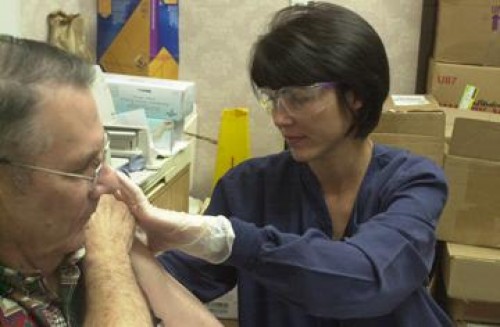Junior " To-To" Pellegrin
November 10, 2006
Quilts auction to benefit local groups
November 15, 2006Many healthcare providers along the Gulf Coast took a hit from either Hurricane Katrina or Rita, but one stood through the winds, rain and flooding while caring for victims of both storms.
More than a year later, the face of Leonard J. Chabert Medical Center has changed. A new director has a new set of issues to resolve. Chabert continues to suffer from an epidemic most hospitals around the state share, a lacking nursing staff.
The storm reduced the already low number of nurses around the region and, according to Rhonda G. Green, director of the hospitals nursing department, there was a national shortage even before the storms.
A Critical Need
“Chabert, like so many other hospitals, is in need of additional nursing staff,” said Green. “The Louisiana State Board of Nursing reported that over 800 (registered nurses) left the state during the post-Katrina era. Fortunately, Chabert has a low turnover rate of long-time nurses. We are often told that the ‘family environment’ is what attracts and keeps many nurses employed at our facility.”
Jean Huin, spokesperson for the Louisiana State Board of Nursing, said analysis of 2004 data shows the shortage has been an ongoing problem, not only among registered nurses, but also nurse practitioners.
That year, 600 full-time and 300 part-time practitioner positions were left vacant, on top of a need for 500 nurses to fill newly created positions. Statistics were not calculated in 2005 due the aftermath of the storms, she said.
With an older workforce, nurses are retiring at higher rates than the number entering the field. Many are choosing to go the route of providing in-home care, which allows flexibility in scheduling and nurses are typically paid more, said Marianne P. McCrory, coordinator of institutional development at L.E. Fletcher Technical Community College Allied Health program.
Louisiana’s situation was only exacerbated by the storms. While many nurses left the state, more people have become sick and illnesses are more complex, requiring even more in-hospital care, she said.
“With the opening of the Allied Health Houma campus in 2005, additional educational opportunities are available for local students considering careers in the nursing field. Part of the problem is that there are not enough seats in classrooms for students to get a degree,” said Green.
About 60 students are enrolled in Fletcher’s 15-month practical nursing program according to program director Marcie Guidry, and the college will begin offering a registered nursing program that will accommodate 30 additional students upon accreditation.
Fletcher strives to offer an exceptional classroom experience by maintaining a 1-to-10 student-instructor ratio.
The practical nursing program has existed for 40 years; only now has Fletcher entertained the idea of adding a registered nursing program due to the limited number of programs in the area, said Guidry. Students who choose to continue after receiving a practical nursing degree will try to enter Nicholls State University’s program, but space is limited.
“There is definitely a shortage, not only with staff nurses, but with nursing instructors as well. We have been advertising for about a year now and there have been no applications. If we had more instructors we could increase student enrollment,” said Guidry.
Working Together to Educate
Chabert and Fletcher have a strong working relationship in order to provide students with rigorous training and available job opportunities for graduates. To become licensed, students must complete 800 hours of clinical training and Chabert provides a unique setting to meet that requirement.
Students are able to utilize the relationship Fletcher has with local hospitals when it comes time to find a job. Guidry was told that Chabert is in need of 22 registered nurses – its current staff works 12-hour shifts – and said that Terrebonne General Medical Center is in a comparable situation.
Guidry said that type of open relationship between the college and area hospitals provides students with an easy transition from the classroom into the workplace.
“The need is definitely out there and we are looking at how we can meet that need,” she said.
To attract more young people to the field of nursing, Fletcher tries to provide information to students about healthcare career opportunities. Job fairs, open houses, Web site access, and summer camps allow students to explore their options.
“Honestly, for me, this was a life-changing decision,” said Leonkia Washington who will graduate from Fletcher in the spring.
Washington refocused her career goals, originally wanting to be a teacher, after the death of her uncle, caused by double pneumonia. Washington felt somewhat responsible because the symptoms were present.
“It was a realization for me because I wanted to help him. Now I want to go a step further and help others know the symptoms,” she said.
Planning to go back to school after graduating, Washington will pair her nursing degree with an education degree to become an instructor.
Crystal Breaux is both a full-time mother of twins and a nurse-in-training.
Choosing the medical field for the same reason as Washington, to help people, Breaux has admits the training is not easy. The workload is strenuous; exceeding the eight hours spent in the classroom, she said.
“I leave here at 2 p.m. and pick up the kids and get dinner ready. My husband gets home at 5 p.m. I study from then until 10 p.m.,” said Breaux.
The senior class started with 47 students, and is down to 12 because of the demanding curriculum.
Green said that other local universities offer programs similar to Fletchers.
Nicholls State University students undergo intensive training with a staff nurse through a Bachelor of Science preceptorship program.
In the Meantime
“Our current staff has been working hard to keep up with the demands of our post-Katrina increases. We really haven’t had to bring in agencies or outside nurses. Our own staff has been working overtime and come in on their days off to help meet challenges,” said Green.
Larry Walker was appointed as the head director at hospital, and improving the nursing situation is incorporated in his overall goal for Chabert n creating a premiere care center.
“In the short time Mr. Walker has been here, we have already felt his presence,” said
Green. “He has already begun to address the nursing shortage and has met with all hospital staff in open forums to offer his support and inform us of his vision for the future of the hospital.”
Walker said that providing pay incentives as well as better benefits will attract people to the nursing field, and with the right working environment, many will choose to work at Chabert.
“Healthcare workers don’t just work for money so another prime issue is assuring that we have the right culture, which I do believe we have here at Chabert,” said Walker. “We as administrators are concerned about every employee as an individual. Having the right family culture is appealing for all of us.”
Haley Guidry administers a flu vaccination to Joe Hebert at the Terrebonne General Medical Center Clinic located in Southdown Mall, one of the many hands-on training experiences nursing students receive at L.E. Fletcher Technical Community College. Staff photo by Andrea Carlson.












